This article summarizes findings from a full-length study. Read the full report here. All figures in this article are sourced from the full study.
Study Scope
This first-of-its kind study examines Canada’s evolving healthcare landscape as technology becomes a mainstay of the digital future.
This study includes:
- Key trends in health technology
- The impact of centralized health records on data management and patient access to data
- A snapshot of Canadian health technology companies
- Health technology labour and skills needs
- Barriers to health tech adoption and recommendations for overcoming the hurdles

Study Context
Healthcare spending in Canada is expected to rise in the coming years, whereas Canada’s ability to adequately meet the costs of healthcare is uncertain.
- In 2019, healthcare accounted for 11.5% of Canada’s GDP
- In 2021, healthcare spending is expected to account for 12.7% of Canada’s (GDP), totalling $308 billion, or $8,019 per Canadian (Canadian Institute for Health Information)
- Healthcare spending is expected to continue to increase by between 4.6% and 6.4% per year until 2030 (Fraser Institute)
- Canada’s debt-to-GDP ratio is expected to increase to about 52% in 2021–2022, from 31% in 2019–2020
This report also addresses how the healthcare sector can continue to serve a growing and aging population while managing costs, modernizing healthcare, and adopting new technologies.

Photo by the CDC on Unsplash
Study Findings
Defining Healthcare Technology
The health technology industry includes companies, products, and services that:
- Use information and communication technologies in prevention, diagnosis, treatment and post treatment, and for telemedicine, care coordination, and data sharing
- Use big data to identify correlations between gene sequences and diseases to aid in the design of novel drugs, and tailor treatments to individual patients based on their DNA sequences (bioinformatics)
- Use biotechnology for medical purposes, including the engineering of genetic cures, or designing organisms that create antibiotics (red biotech)
Health Technology Trends
Electronic Health Records: The transition from paper to electronic documentation was early trend in health technology, beginning in the 1990. A hybrid paper/electronic records documentation system exists today across Canada’s health sector.
Telehealth Services: “Telehealth” or “telemedicine” is an alternative to in-person consultations with healthcare professional — conducted by telephone, audio/video call. COVID-19 lockdowns spurred the use of telehealth services in Canada.
Wearable Technology: “Wearables” are Internet of Things (IoT) devices that can be worn on a user’s body to collect data using sensors, microprocessors, network connections, and cloud technologies. Collected data includes: heart rate, blood-oxygen or blood-glucose levels; calorie use and step count; sleep, water intake, or fall detection.
Annual investments in the global digital health industry have grown substantially over the past decade.

Big Data, Machine Learning, and Artificial Intelligence
Big health data is “the ability to analyze large volumes of different types of data from a variety of sources that are continuously generated.”
· Big health data will enable the application of artificial intelligence (AI) and machine learning (ML) in the health sector, which is currently “in an embryonic phase” in Canada, according to study interviews
Prominent Canadian Healthcare Industries and Tech Verticals
Technology companies transcend traditional sector and industry categories. The most important industry group is pharmaceuticals and biotechnology:

Location of Canadian Company Headquarters
Among health tech headquartered in Canada, the companies in the dataset are primarily located in Ontario (44%), British Columbia (20%), Quebec (18%), and Alberta (10%).
Company Maturity
About 98% of the companies in the health technology dataset are SMEs.
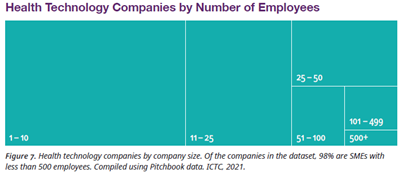
Health Tech Capitalization
Among Canadian companies in the dataset, 56% obtained venture capital backing. After venture capital, the second most common type of financing is from an accelerator or incubator, followed by corporate backing, angel investors, and private equity.
Health Tech Labour Needs
ICTC’s Digital Talent Outlook 2025, identifies health and biotechnology as a key innovation area for the Canadian economy, with a demand for approximately 14,000 workers, for a total employment of 129,000 by 2025.
Key Roles and Skill Sets in Various Health Technology Companies
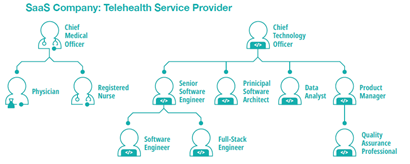
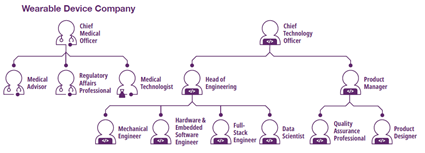
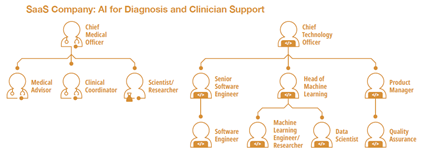

Interdisciplinary Teams
Domain knowledge and business knowledge are both crucial to the success of an AI product development team, which also applies to health tech innovation teams.
Classic roles such as software engineers are in high demand, but an ideal candidate has a combination of tech skills and clinical skills.
Nearly half of interviewees in this study reported difficulty of finding and retaining interdisciplinary workers.
Core Technical Roles
Roles that are common across different types of health tech companies include the following:






Technology Adoption in Canada’s Healthcare Sector
Canada’s pre-pandemic health technology adoption rates are low compared to international counterparts and lags in experimentation and implementation compared the U.S.
- According to the Canadian Health Policy Institute, only 3% of Canadian healthcare spending was directly allocated to health technology, placing Canada 60 out of 72 countries in health tech spending.
Several interviewees link this lack of capital to low health technology adoption rates.
Adoption by Region
Health technology adoption rates depend on age distribution, healthcare expenditure, population density, proximity to urban centers, and population health needs.
Interviewees noted the highest levels of health technology adoption in densely populated urban areas such as Toronto, Ottawa, and Vancouver.

Adoption by Technology
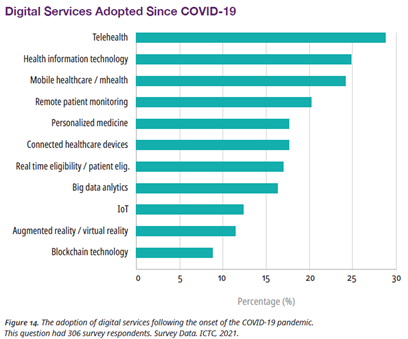
Barriers to Adoption
Thousands of new technologies attempt to enter the Canadian market each year, however, they face a variety of hurdles, including regulation and procurement.
Regulation: High-quality standards protect Canadians, however, obstacles to adoptions include a lack of help for navigating Canada’s regulatory approval process, a time-consuming approval process, and regulatory processes that don’t keeping pace with the rapid rate of health technology innovation and software performance improvements.
Procurement: Canada’s healthcare is a publicly funded system designed to provide patients with affordable, high-quality care. However, a focus on affordability has resulted in complex procurement, regulatory, and funding mechanisms that support bulk-purchasing based on price rather than patient outcomes.
Canada is, however, well positioned to make the transition to value-based procurement, which would both encourage industry market entry and health technology adoption.
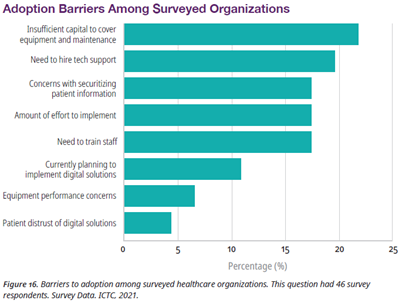
Compensation Barriers to Tech Adoption
Most physicians in Canada are compensated through a fee-for-service (FFS) model, which compensates based on the procedure delivered, which results in:
- No incentive for physicians to adopt new technologies that result in better health outcomes because physicians are not compensated for services without billing codes
- A disincentive for new technology adoption that could reduce the number of services physicians need to provide their patients
Most interviewees, however, suggested that if billing codes change, physician adoption of technology will follow.
Organizational Culture Barriers
A lack of support and stakeholder engagement in tech adoption can become cultural resistance to change within organizations.

Talent and Skill Capacity Needed for Tech Adoption
Almost 20% of survey respondents noted lack of talent and skills capacity as a factor preventing them from adopting health technologies. Tech adoption therefore require:
- The hiring of tech support
- Additional resources to implement the technology
- Staff training
Proper implementation of technology in healthcare organizations will be needed to avoid the risk employee burnout and uneven adoption.

This article summarizes findings from a full-length study. Read the full report here
